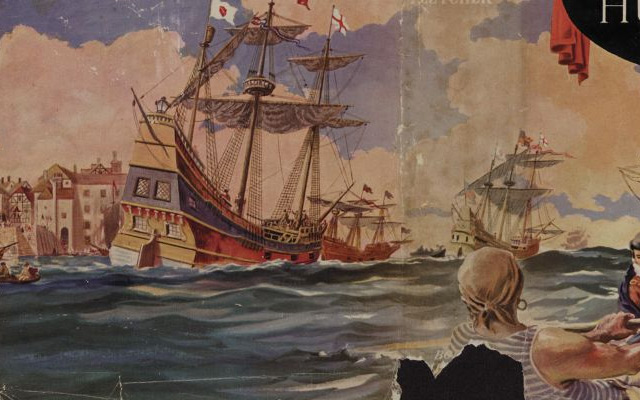Signet ring
- Title
- Signet ring
- Description
- Brass signet ring engraved with a prancing lion crest. Research results indicate it is probably of early 17th century origin, but a late 16th century origin can’t be definitively ruled out. The ring was excavated at the Cape Creek site (Croatan), Buxton, Dare County, North Carolina, in 1998 during the Croatan Archaeological Project, which was directed by East Carolina University Professor Emeritus David Sutton Phelps. Date approximated.
- Date
- 1600-1650
- Original Format
- jewelry
- Extent
- 1cm x 2cm
- Local Identifier
- 1061
- Contributor(s)
- Subject(s)
- Roanoke Colony
- Roanoke Island (N.C.)--History--17th century
- Archaeological assemblages--North Carolina--Buxton
- Excavations (Archaeology)--North Carolina--Buxton
- Rings--North Carolina--Buxton
- Spatial
- Location of Original
- East Carolina Manuscript Collection
- Rights
-
This item has been made available for use in research, teaching, and private study. Researchers are responsible for using these materials in accordance with Title 17 of the United States Code and any other applicable statutes. If you are the creator or copyright holder of this item and would like it removed, please contact us at als_digitalcollections@ecu.edu.
http://rightsstatements.org/vocab/InC-EDU/1.0/ - Permalink
- https://digital.lib.ecu.edu/927
- Preferred Citation
- Cite this item
- This item
-
 Signet ring
Signet ring
- My Collections Login
- Printable Feedback Form
- Found in theme/project
-
 Early American History
Early American History
- Location of Original
- Croatan Archaeological Site Collection from the East Carolina Manuscript Collection
- View all digitized items from the Croatan Archaeological Site Collection
Related Search Results
Public access is provided to these resources to preserve the historical record. The content represents the opinions and actions of their creators and the culture in which they were produced. Therefore, some materials may contain language and imagery that is outdated, offensive and/or harmful. The content does not reflect the opinions, values, or beliefs of ECU Libraries.
Contact Digital Collections
If you know something about this item or would like to request additional information, click here.
Comments
G. Smith is quite right. Hakluyt's Principle Navigations volume 8 p.416 reports that John White found on a tree by the beach "CRO : which letters presently we knew to signifie the place, where I should find the planters seated" On p.417 he further reports that John White found on a tree by the fort entrance "in fayre Capitall letters was graven CROATOAN without any crosse or signe of distresse;" Both were carved in capital letters as written in the report. .
To be honest, I would be willing to bet that this was most likely an heirloom of the Towles family of Accomac County Va.My reasoning is that Henry Towles married a Kendall in the mid 17th century and it was Henry Towles who was been cited as having sealed an official document with his family signet ring - a lion passant; not the Kendall family.
Observation: In National Geographic and other sources, the word you have spelled here, "Croatan", is spelled "Croatoan". Signed: An old proofreader who can't help herself.
Correction to first words in previous post: "A gilded copper-alloy signet ring"
A gilded copy-alloy signet ring of very similar style was found near Shoreham-by-Sea in West Sussex, England, in May 2004. It is nearly identical in design (less worn), age (1400-1600 AD), and size (Width: 4.2 mm, Diameter: 20.8 mm, Thickness: 2.1 mm, Weight: 4.72 g) Shoreham-by-Sea is on a bay between Worthing and Brighton along the British Channel shoreline. That is about 260 miles east of Pelyn, Cornwall, where the Kendall family with lion passant crest was living in the 16th century. Notably, the curator of the British Museum's "virtual museum" website tags the design as a "standing lion" aka rampant. The posting can be found at http://finds.org.uk/database/artefacts/record/id/67514. Unique ID is SUSS-C937A8. It would be interesting to know what an expert in medieval signet rings would conclude by comparison of the West Sussex find to the one found on Hatteras. Same craftsman? For same person/family? Perhaps a less expensive copy of the gold ring found on Hatteras?
It would be helpful to have a link from this digital collection page to the manuscript collection page about this item - http://digital.lib.ecu.edu/special/ead/findingaids/1061/ - where there is more of a description of Dr. Phelps findings. Thank you for sharing this discovery with us.
This is a great presentation for this unique find. Kudos to Dr. Phelps and ECU!One thing please. Is it possible to pause the 360 degree video and continue without starting over so one can study it at different angles?
you need flash player to watch, you can get it here: http://get.adobe.com/flashplayer/
the 360 view is accessible again :]
you used to be able to view this as a 360 image - where did it go?
Marvelous find. Dr. David S. Phelps was a marvelous director and archaeologist. Forever, my hat's off to him.
Comment on This Item
Complete the fields below to post a public comment about the material featured on this page. The email address you submit will not be displayed and would only be used to contact you with additional comments or questions.



The prancing or dancing lion is normally associated with the Sutton family. One of the lost colonists, Martyn, was also a Sutton. The Kendall family crest is different...